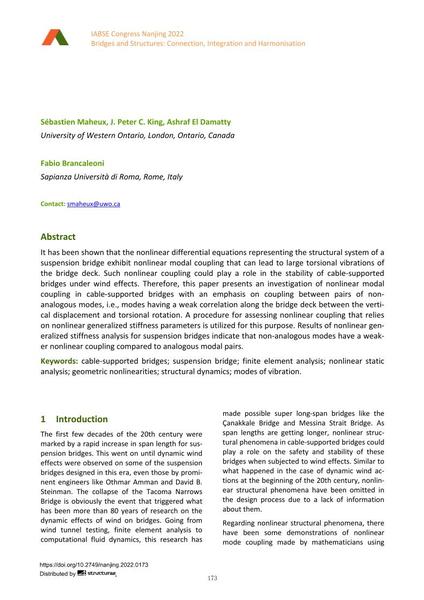Nonlinear Coupling in Cable-Supported Bridges for Non-Analogous Modes

|
|
|||||||||||
Bibliografische Angaben
| Autor(en): |
Sébastien Maheux
(University of Western Ontario, London, Ontario, Canada)
J. Peter C. King (University of Western Ontario, London, Ontario, Canada) Ashraf El Damatty (University of Western Ontario, London, Ontario, Canada) Fabio Brancaleoni (Sapianza Università di Roma, Rome, Italy) |
||||
|---|---|---|---|---|---|
| Medium: | Tagungsbeitrag | ||||
| Sprache(n): | Englisch | ||||
| Tagung: | IABSE Congress: Bridges and Structures: Connection, Integration and Harmonisation, Nanjing, People's Republic of China, 21-23 September 2022 | ||||
| Veröffentlicht in: | IABSE Congress Nanjing 2022 | ||||
|
|||||
| Seite(n): | 173-181 | ||||
| Anzahl der Seiten (im PDF): | 9 | ||||
| DOI: | 10.2749/nanjing.2022.0173 | ||||
| Abstrakt: |
It has been shown that the nonlinear differential equations representing the structural system of a suspension bridge exhibit nonlinear modal coupling that can lead to large torsional vibrations of the bridge deck. Such nonlinear coupling could play a role in the stability of cable-supported bridges under wind effects. Therefore, this paper presents an investigation of nonlinear modal coupling in cable-supported bridges with an emphasis on coupling between pairs of non- analogous modes, i.e., modes having a weak correlation along the bridge deck between the verti- cal displacement and torsional rotation. A procedure for assessing nonlinear coupling that relies on nonlinear generalized stiffness parameters is utilized for this purpose. Results of nonlinear gen- eralized stiffness analysis for suspension bridges indicate that non-analogous modes have a weak- er nonlinear coupling compared to analogous modal pairs. |
||||
| Stichwörter: |
Finite-Elemente-Analyse Hängebrücke Baudynamik
|
||||
| Copyright: | © 2022 International Association for Bridge and Structural Engineering (IABSE) | ||||
| Lizenz: | Die Urheberrechte (Copyright) für dieses Werk sind rechtlich geschützt. Es darf nicht ohne die Zustimmung des Autors/der Autorin oder Rechteinhabers/-in weiter benutzt werden. |
||||

